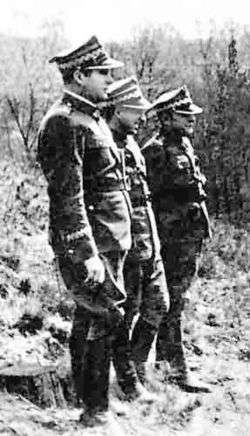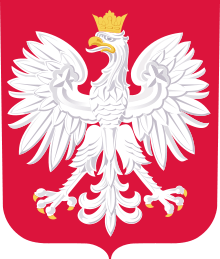Michał Rola-Żymierski
| Marshal Michał Rola-Żymierski | |
|---|---|
 Michał Rola-Żymierski as Marshal of Poland | |
| Born | September 4, 1890 |
| Died | October 15, 1989 (aged 99) |
| Allegiance |
|
| Service/branch |
Austro-Hungarian Army (1911 - 1914) Polish Legions (1914 - 1919) Polish Army (1919 - 1927) People's Guard (1942 - 1944) People's Army (1944) People's Army of Poland (1944 - 1989) |
| Years of service | 1911 - 1927; 1942 - 1949 |
| Rank | Marshal of Poland |
| Battles/wars | World War I. Polish-Soviet War, 1926 Polish Coup d'Etat, World War II |
| Other work | Minister of National Defence |
Michał Rola-Żymierski (pronounced [ˈmixaw ˈrɔla ʐɨˈmjɛrskʲi]; September 4, 1890 – October 15, 1989) was a Polish high-ranking Communist Party leader, communist military commander, NKVD secret agent, and Marshal of Poland by Joseph Stalin's order from 1945 until his death. He supported the 1981 imposition of the Martial law in Poland.[1]
Biography

Rola-Żymierski was born Michał Łyżwiński in Kraków under the Austrian Partition, to a family of railway clerk Wojciech Łyżwiński. At the age of 20, he enrolled at the law faculty of the Jagiellonian University in 1910, but was drafted a year later.[2] After his brother committed widely publicized murder-robbery in Kraków, he began to call himself Żymierski around 1913.[1] When World War I erupted in 1914, he joined the Polish Legions, and fought with distinction on many of the most important battlefields of the Austro-Hungarian Eastern Front. After the Oath Crisis of 1917 he retired from the Austro-Hungarian army and returned to Kraków, where he graduated from the Kraków Trading School.
In 1918 he joined the reborn Polish Army and took part in the Polish-Soviet War. He initially commanded the II Infantry Brigade and then was promoted to the commander of the prestigious Polish Legions 2nd Infantry Division. After the war he was sent to Paris, where he graduated from École spéciale militaire de Saint-Cyr.[2] Upon his return he was promoted to General. Żymierski served in Warsaw as the Deputy Chief of Administration of the Polish Army. During the 1926 coup d'état he defended the democratically-elected government of Stanisław Wojciechowski. After the coup, in 1927, the new sanacja regime of Marshal Józef Piłsudski charged him with bribery and embezzlement. Following official investigation, he was court-martialed and demoted to private first class, expelled from the army and sentenced to five years in prison.[2]
Upon his release in 1931 Żymierski went to France. He was canvassed by the Soviet intelligence and became a well-paid secret agent delivering information about Franco-Polish alliance. He joined the Communist Party of Poland. His secret engagement with Moscow was discontinued when Stalin ordered the dissolution of the Polish Communist Party (KPP) in 1938 during the Great Purge.[2]
World War II
Żymierski returned to Poland shortly before the Nazi-Soviet invasion of Poland at the onset of World War II,[2] and soon resumed his clandestine work for the NKVD (as revealed first by Józef Światło). Under the pseudonym "Rola", he engaged in the Soviet dealings with Nazi German Gestapo secret police. In 1943 by the Soviet executive order he was named the deputy commander of the Communist and Soviet-backed Gwardia Ludowa, and since 1944, the commander of Armia Ludowa. He was promoted by the communist-backed Polish Committee of National Liberation back to the rank of General and became the commander-in-chief of the Polish Army fighting alongside the Soviet Union (the Polish Armed Forces in the East). He was Minister of Defence in the Provisional Government of Republic of Poland (Rząd Tymczasowy Rzeczypospolitej Polskiej, January–June 1945). On May 3, 1945, by order of Stalin he was promoted to the rank of Marshal of Poland.[2]

Since 1946 Żymierski served as head of the Commission of State Security. He was responsible for repressions against the former resistance fighters, members of the Polish 2nd Corps and non-communist politicians, as well as for the deployment of the Polish Army against Poland's Freedom and Independence fighters; and the roundup of Ukrainian families in Operation Vistula against the OUN-UPA. Until 1949 he also held the post of Minister of National Defence. In this year he was replaced by allegedly Polish-born Soviet Marshal Konstanty Rokossowski, who received the rank of Marshal of Poland and held his office until 1956. As an effect of Stalinist purges organised in Poland by Bolesław Bierut Żymierski was arrested in 1952. However, he was released in 1955 without any charges. He was rehabilitated by the Polish government in 1956.
After the end of Stalinism in Poland he held various posts, including deputy head of the National Bank of Poland (between 1956 and 1967) and the honorary head of the ZBoWiD (Society of Fighters for Freedom and Democracy, an organisation of Polish war veterans). He was also a member of the Polish United Workers' Party and after Wojciech Jaruzelski's introduction of martial law in Poland Żymierski also became the member of its Central Committee and of the Front of National Unity.
He died in Warsaw on October 15, 1989. He was the last officer to date to hold the rank of Marshal of Poland.
Honours and awards
- Order of the Builders of People's Poland (1970)
- Knight Grand Cross of the Order "Virtuti Militari"
- Silver Cross of the Order "Virtuti Militari"
- Knight Grand Cross of the Order of Polonia Restituta
- Commander of the Order of Polonia Restituta
- Cross of Grunwald 1st class
- Four Crosses of Valor
- Order of the Banner of Work 1st class
- Partisan Cross (1946)
- Medal of the 30th Anniversary of People's Poland
- Medal of the 40th Anniversary of People's Poland
- Medal for Warsaw 1939-1945
- Medal for Odra, Nysa, and the Baltic
- Victory and Freedom Medal 1945
- Medal for Participation in the Fighting in Defense of People's Power
- Medal Rodła
- Medal "For Contributions to National Defence"
- Wound badge
Foreign awards
- Order of Victory № 17 (USSR)
- Order of Lenin (USSR)
- Order of Friendship of Peoples (USSR)
- Chief Commander of the Legion of Merit (USA) (personally awarded by General Eisenhower, Frankfurt, 1945)
- Knight of the Legion of Honour (France)
- Order of the White Lion 1st class (Czechoslovakia)
- Order of the People's Hero (Yugoslavia)
- Jubilee Medal "Twenty Years of Victory in the Great Patriotic War 1941-1945"(USSR) 1965
- Jubilee Medal "Thirty Years of Victory in the Great Patriotic War 1941-1945" (USSR) 1975
- Jubilee Medal "Forty Years of Victory in the Great Patriotic War 1941-1945" (USSR) 1985
| Wikimedia Commons has media related to Michał Żymierski. |
References
- 1 2 Prof. Jacek Wijaczka (2016). "Michał Rola-Żymierski. Honorowy Obywatel Miasta (tytuł odebrany)". Urząd Miasta Torunia.
- 1 2 3 4 5 6 Informacja historyczna (2012). "Michał Żymierski (1890–1989)". Warszawa: Instytut Pamięci Narodowej.
W 1927 roku wyszły na światło dzienne malwersacje, jakich Żymierski dokonał w okresie sprawowania funkcji ministerialnej. Podczas procesu udowodniono mu popełnienie nadużyć i przyjęcie korzyści majątkowych. Niezawisły sąd skazał go prawomocnie na degradację, wydalenie z wojska i 5 lat więzienia.
- Jarosław Pałka, Jerzy Poksiński, Michał Żymierski 1890–1989, Warszawa 2015
- Sprawa karna Michała Żymierskiego (2)
- Sprawa karna Michała Żymierskiego (3)
Further reading
- Andrew A. Michta, Red Eagle: The army in Polish politics 1944-1988.
